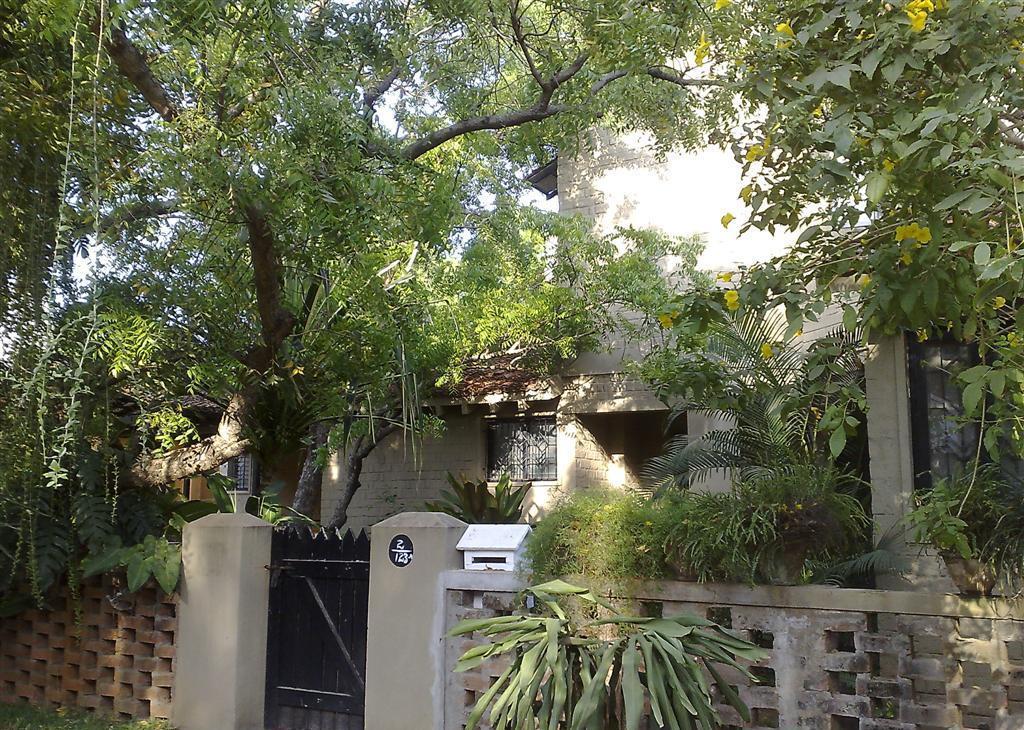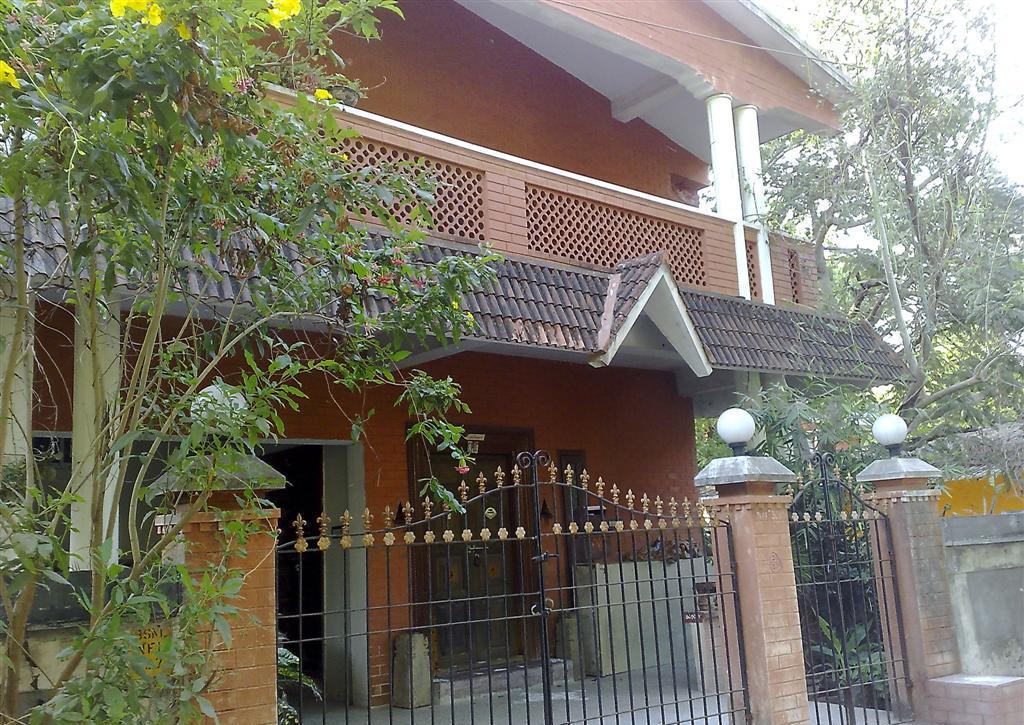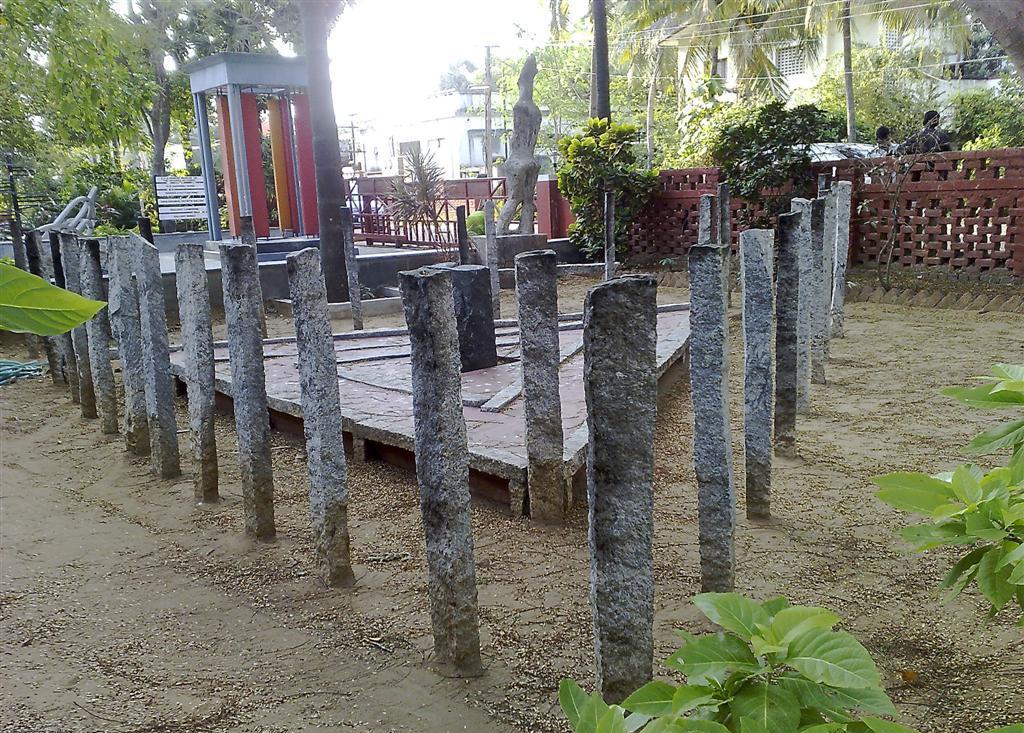Cholamandalam Artists'
Village, Chennai
The Cholamandalam Artists Village situated about 9 km from Chennai
city is a haven for art lovers and artisans alike. Set amidst 10 acres of land,
this artist village showcases contemporary art. It is the country's largest
self-supporting art village. Way back in 1964, the principal and students of
the Madras School of Arts and Crafts set up this institution that has come to
be recognized as a significant school of art and crafts.
Located in Injambakkam on the East Coast Road, this village is
named after the Chola dynasty that patronized arts and crafts. At that time,
there were no institutions or outlet for those seeking to pursue a career in
arts. The Late K.C.S Paniker was one of the pioneering spirits behind the Cholamandalam
Arts Village in Chennai. Artists live as a community and pooled together their
skills and resources.
The Cholamandalam Arts Village has a permanent art gallery to hold
exhibitions. Sculptures made of granite; wood, copper and bronze are created
within the Artists Village. The open-air theater is a platform for performing
artists or even poetry reading sessions and dance recitals.
Indian arts such as batik and pottery and painting are seen in the
myriad articles and works done by the artists of the Cholamandalam village. You
can view or purchase interesting pieces in terracotta and batik. In fact
Cholamandalam has grown to be an important hub or meeting place for
international artistes in sylvan surroundings. Visitors to the Cholamandalam
Artists Village can get to see different art forms on display. There are 2
gallery halls. You can even walk down and see the interesting houses of the
artists. There is an exhibition hall too. Visitors are allowed between 10.00am
and 7.30pm.
The Cholamandalam Arts Village is a fascinating place with its
picturesque environs close to the shores of the turquoise waters of the Bay of
Bengal. The village hosts a permanent art gallery to hold exhibitions. So if
you are into art, whether for investment purposes or just for the love of the
subject, this is a place you should visit.
The village is a hotbed of artistic ventures and you can pick up
unusual pottery or works of art in batik or terracotta. This sylvan hamlet has
developed into an important focal point for international artistes. It hosts a
variety of fairs and exhibitions to create awareness about India’s dying or
lost arts. If you are an art buff, Cholamandalam is a must visit. You can pick
up exclusive works of art and also souvenirs for gifting.
Cholamandalam Artists Village, established in 1966, is the largest
artists' commune in India, whose artists are credited for the Madras Movement
of Art (1950s–1980s), which brought modernism to art in South India. Their work is widely recognized as some of the best art produced
in postwar India, and is shown regularly in galleries across the country; in
fact several Cholamandalam artists have also shown in Europe, the United States
and South America. Situated at village Injambakkam, 9 km from Chennai, India, it has over twenty resident painters and sculptors, who live as
a community and pool their skills; they also run the Artists Handicrafts
Association, a cooperative which manages the village and sale of works through
the permanent exhibition at the complex, which includes paintings, sketches,
terra-cotta/stone/metal sculptures, batiks and handicrafts etc., made by the
artists living the village, making the village a self-supporting entity.
The community was founded by K. C. S. Paniker, the principal of the Madras School of Arts, along with his students and a few artists associated with the
college. It used the `art-meets-craft' approach where artists made handicrafts
for a living even as they pursued their art. By the 1970s, the village became
self-sufficient, and grew into one of the most important meeting places for
international artists in India, and today, it remains one of the few
artist-driven movements in India. Four decades on, it is one of the few
artists' colonies in the world to survive successfully and its foundation
remains one of the "10 biggest art moments" in India.
The Cholamandalam Artists Village is an idyllic place located
on 10 acres of land, about nine km from Adyar, Chennai – along the New
Mahabalipuram road. Being India’s largest self-supporting artists’ village and
one of the most successful in Asia, this beautiful village is truly a magnum
opus of contemporary art. It is equipped with all that is needed for an arts
village, esp. the open-air theatre Bharathi that is used for holding
discussions and conferences. It has earned reputation world over and is now,
one of the major tourist attractions in the Coastal city.
A painter himself, K.C.S. Paniker who was the prime visionary
behind this whole setup “Cholamandalam”, gave contemporary Indian art, a
lifeline. Alongside the founding father, many of the painters and sculptors
retired from Cholamandalam. Nevertheless their accomplishments speak eloquently
for themselves and Paniker had inadvertently sparked a legacy that has kept its
proud father’s work perpetual.
History
Cholamandalam Artists Village, established in 1966, is the largest
artists commune in India, whose artists are credited for the Madras Movement of
Art (1950s–1980s), which brought modernism to art in the South India. Their
work is widely recognized as some of the best art produced in postwar India,
and is shown regularly in galleries across the country; in fact several
Cholamandalam artists have also shown in Europe, the United States and South
America.
The community was founded by K C S Paniker, the principal of the
Madras School of Arts, along with his students and a few artists associated
with the college. It used the `art-meets-craft' approach where artists made
handicrafts for a living even as they pursued their art. By 1970s, the village
became self-sufficient, and grew into one of the most important meeting places
for international artists in India, and today, it remains one of the few
artist-driven movements in India. Four decades on, it is one of the few
artists' colonies in the world to survive successfully and its foundation
remains one of the "10 biggest art moments" in India.
Back in the fifties, the spot was part of an uninhabited stretch
of sand with casuarina plantations. At that time, most of the artists who live
and work here now were students of the Government school of Arts and crafts,
Chennai (Previously known as Madras).It has completed almost four decades of
existence autonomously.
What is remarkable about its development is that it has grown into
what it is now, without any funding or support from the government,
quasi-governmental bodies, charitable foundations, art bodies like Lalit Kala
Academy or persons apart from the small grant that it is entitle to, like any
other art organization in the country.
The land where the artists set up their village was purchased with
their own money. They built everything including their houses, studios,
gallery, theatre, workshop and kitchen, on their own. On the whole, the artists
who make up this settlement owe their village and the living they have managed
out of it to nobody's charity, patronage, munificence or eccentricity.
Towards the end of the fifties many painters and sculptors in the
school of Arts and Crafts joined hands with him in search of what amounted to a
new way of life in contemporary art. This was an exciting venture, which soon
proved to be exacting as well.
For a living, the artists here practiced as art teachers in
schools or as designers but they were permitted too little time for sustained
creative work. Part time work of two or three hours a day where the artists
could freely extend their art on to a congenial craft of utilitarian nature
appeared to be the answer. But a couple of years down the line, a need for a residential
work-centre for artists at a conducive place preferably near the sea on the
outskirts of the coastal city with transport facilities and Cholamandalam was
born. Since an ancient dynasty named Chola that encouraged arts ruled this area
in the Coromandel Coast, it was baptized as Cholamandalam.
Most of the original founding creative artists, painters and
sculptors were students and artists associated with the Government School of Arts and Crafts,
Chennai (Madras School of Arts),
where K.C.S. Paniker, noted
metaphysical and abstract painter, was principal 1957 to 1967. These artists
desired to form a congenial space for practicing their art; thirty eight of
them got together and formed the 'Artists Handicrafts Association' (AHA) in
1963 initially to sell the works of artists.
Gradually the artists started working together, producing
handicrafts in their spare time, they were among the first in the country to
produce batik fabric, and proceeds of their first batik exhibition went
into buying the 8.5 acres (34,000 m2) of land in 1966, which was to make
up the village. By now K.C.S. Paniker had retired and founded the artists
commune in April 1966. It was named after the Chola dynasty, which is known to have encouraged arts and ruled the region,
9-13th century AD; called Cholamandalam in Tamil, which literally translated as The realm of the Cholas,. Chola also lends its name to the Coromandel Coast of Bay of Bengal, which is few minutes of walk away from the village. Another
reason was the Paniker was "worried that his students might deviate from
art due to financial compulsions".
In the same year six artists moved into live and work on their own
land. In the 60s, while they could hardly sell their paintings, avant garde
wood and leather work, batik, ceramics and metal craft made by them, found a
good market, this sustained them for the duration, while the local buyers were
familiarized to modernism, which their art represented.
Electricity was provided only in 1968 and till 1972 the mud road
ended at Muttukadu. Then
situated on a lonely, bumpy road, now known as the East Coast Road highway to Mahabalipuram, from Adyar, and Chennai was
still further away, though today due to rapid expansion, it is right at its
door steps, and the road is busy with traffic and shops and commercial
establishments. Over the years, built their houses, studios, exhibition
gallery, theatre, workshop and kitchen, which they jointly owned along with all
the infrastructure of the village. Apart from that it nurtured artists such as
P.S. Nandan, Haridasan, S. Nanda Gopal, Vasudev, K.Jayapala Panicker, Gopinath,
Senathipathy, M.V. Devan and Richard Jesudas. Soon they formed a cooperative to
look after the village, also built a gallery, which displayed and sold their
works; 20% of their sales went to their association ‘Cholamandalam Artists
Handicrafts Association’, which used the funds for the upkeep of the Village.
In time the cooperative became self-sufficient and held exhibition of their
work in major cities of India.
K.C.S. Paniker died in 1977, but by this time the village had
become self-sufficient, without any government funding, and the module had
proven sustainable. Over the years, work done by the artists at the
village, initiated a period in south Indian art called the 'Madras Movement',
which brought modernism to south Indian art. Progressive Painters’ Association (P.P.A), one of the
oldest art associations in India founded by Paniker in Chennai in 1944, after
remaining inactive for many year after Paniker's death, the association was
revived in 2006, and a new committee formed, it is now being carried forward by
artists at the village, and an annually elected general council of members
administers Cholamandalam. The village still continues to produce artists of
great talent such as S. Ravi Shankar, A. Selveraj and Shailesh B.O. amongst many others.
Cholamandalam Centre for Contemporary Art
During his last days Paniker had offered his oeuvre to the Madras
government on the condition that a separate gallery be created for his work,
when no response came from the government, eventually the Trivandrum Art
Gallery took up the offer, an now houses an important collection of Paniker's
work, but the artists at the village wanted a place for displaying all the
works of Madras Movement at the place, thus idea of the art museum took place.
The artists raised money from the private sector to found a museum
within the village, which would house a permanent collection of artworks
representative of the Madras Movement. While the initial design was made
by a visiting Dutch couple, the design for the art centre was made by
architects Sheila Sri Prakash of Shilpa Architects and M. V. Devan, as project gathered momentum help came in
from various artists and corporates alike. Finally after three and half years
of construction the building was, and thus started a long search for works that
exemplified the Madras Movement, which flourished between the early 50s and the
80s. Eventually about 60 per cent of the works were donated by senior artists
and the rest were given on extended loan by art collectors around the country.
The 'Cholamandalam Centre for Contemporary Art' was opened at the
village on Feb 1, 2009; it has a 'Museum of the Madras Movement', which display
works of all prominent artist of the 'Madras Movement' apart from that of
Paniker, including M. Senathipathi, Late A.P. Santhanaraj, P.S. Nandhan, S.G. Vasudev, K.V. Haridasan, Thotta Tharani, Sculptor S. Nandagopal. Apart
from the museum and a gallery for Cholamandalam artists, the centre has two
commercial galleries, 'Labernum' and 'Indigo', that can be rented free of
commission charge, an art book store, and a craft shop. Outside it is
surrounded by tree-shaded sands which sport an international sculpture garden,
displaying sculptures made by visiting artists from across India and the world
through the decades.
Events
The Cholamandalam Centre for Contemporary Art will be a standing
exhibition comprising of personal contributions from artists of the 'Madras
Movement', to be displayed in the K.C.S.Paniker Museum in its two wings - the
D.P.Agarwal wing and the Rasika Kothari wing. An international sculpture garden
surrounds the main Centre.
Additionally, two commercial galleries, Labernum - H.K.Kejriwal
wing and Indigo - the Tulsyan wing, an art book shop, a craft shop and an
exotic cafeteria are some of the facilities that would be available.
Facilities
Today, the village houses a number of art galleries, museums, and
an open-air theatre on the site also houses dance and theatre
performances. The original Artists Handicrafts Association is still in
charge of the colony, and Paniker's son, sculptor S. Nandagopal, is the
Secretary of the Village. Out of the original forty artists, many are no more,
and some have moved out, only twenty one remain today, and Cholamandalam does
not accept new members, though it has at least a dozen artists living or
working there at any time in the year, plus many artists-in-residence are also
at work here.
The village is open daily from 10am to 5pm. It is 10 minute
walking distance from the Golden Beach. Local transport is now easily available
and the Chennai International Airport the nearest airport.
Facts
Operating Hours: Mon-Sun: 09:30 AM - 06:30 PM
Known For: Paintings, Sketches, Terra-Cotta / Stone / Metal Sculptures,
Batiks And Handicrafts.
Facilities: Art Galleries, Museums and Open-Air Theatre
Entry Fee: Adults - Rs. 20/- Kids (3 To 12 Years) - Rs. 5/-
Contact
Cholamandalam Artist
Village
Injambakkam
Chennai - 600 041, India
Phone: 00-91-44-24490092, 24494053
Connectivity
By Air: Chennai is the nearest airport, which is approximately 15 km
from Cholamandalam. Adequate buses are available to reach Cholamandalam from
there.
By Rail: The two major railway stations - Chennai Central and Egmore
are the nearest railway stations to Cholamandalam. Adequate buses are available
to reach Cholamandalam from there.
By Road: Cholamandalam is well connected by public and private
transport to Chennai and other neighbouring areas.




























































